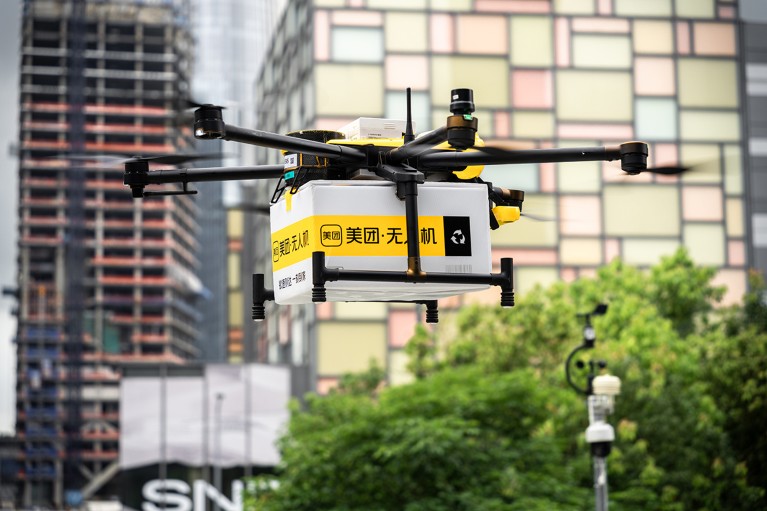
Drones could help cities to achieve net-zero initiatives. However, effective regulations are needed to mitigate any potential harms.Credit: VCG via Getty
This coming year will see a massive increase in the use of small drones for deliveries. Notably, China plans to expand the scale of its low-altitude economy— including drones, vertical take-off and landing aircraft and other general aviation components — to 1.5 trillion yuan (US$207 billion) by the end of 2025, to maintain its lead in such technologies.
The public is used to new technologies entering their lives — artificial intelligence (AI) is already commonplace and autonomous taxis operate on the streets of some cities in China, the United States and elsewhere. However, it remains unclear whether the public is prepared for daily encounters with thousands or even millions of drones in the sky — with their noise, potential crashes and intrusive views into our gardens and windows.
Lethal AI weapons are here: how can we control them?
Little research has been done to find out, and existing regulations fall short. As an aerospace engineer, I have concerns about the immediate release of so many drones owing to potential unintended consequences. Collaboration between academia, industry and governments is essential to ensure that this technology is safe and effective, and not dangerous.
Drones — also known as uncrewed aerial vehicles or flying robots — have proved their worth in many areas, including firefighting, earthquake research, air sampling for virus surveillance, wildlife conservation and more. Initiatives to achieve zero-emissions transport, on-demand deliveries and ‘smart’ cities anticipate large fleets of small drones (up to 25 kilograms) carrying goods along air corridors up to 1,000 metres above the ground.
Fast-growing market
The logistics industry is the main sector investing in this vision. And in China, two key uses are being explored. Transporting takeaway food and medicines by drone direct to customers, which can be quicker than sending them by road in congested cities. And flying larger cargo drones between regional logistics hubs, which can enhance express delivery services and support near-instant retail. Moreover, by reducing the amount of trucks on the roads, drone deliveries might reduce carbon emissions per kilometre by as much as 90% (see go.nature.com/3bxvpxy).
Globally, drone flights have ramped up quickly in the past few years (see ‘Commercial drone markets’). Between 2021 and 2022, drone-assisted package deliveries grew by 80% worldwide, to reach 875,000 items (see go.nature.com/4gwcf5t). And in 2021, The Economist projected that the global economic benefit of using commercial drones for industry and recreation (excluding military) purposes would exceed $42 billion by 2025 (see go.nature.com/4fomdd4).

Source: Analysis by X. Huang
China alone has already approached that prediction — by the end of 2023, China’s commercial drone market exceeded 117 billion yuan and its low-altitude economy (including hardware, software, services, infrastructure, hubs and airports) exceeded 500 billion yuan. On the basis of this, we predict that the commercial drone market will exceed 400 billion yuan by 2025. Currently, more than 70% of the supply chain for the commercial drone industry originates in China. In Shenzhen, China’s leading innovation city, 225,000 commercial drone deliveries were completed during the first half of 2024, and are projected to reach 1.5 million low-altitude cargo flights in 2025. The world’s largest drone delivery company, Zipline, completed more than 1.3 million deliveries over the past decade across four continents.
Public concerns
With hundreds of new commercial drone routes planning to open in China this year, effective regulations for safely integrating drones into existing smart-city systems cannot be overlooked. Scientists must focus on four crucial issues.
Safety. Avoiding harm is the paramount concern for every aerospace engineer — one fatal accident could result in the retirement of a whole family of aircraft. Yet, there have been too few realistic assessments of potential dangers posed by drone collisions, with one another or with buildings, as well as the possible threat to pedestrians in urban areas.
Autonomous ships are on the horizon: here’s what we need to know
Similar to car-crash tests, scientists should develop drone crash tests to simulate a range of accident scenarios, using dummy models on the ground to evaluate the potential severity of incidents in which drones fall from the sky.
The fire safety of drone-recharging hubs, typically located on top of skyscrapers, needs evaluation as well as standards and regulation. The risk of aircraft engines ingesting small drones also needs to be assessed — bird-strike tests and regulations should encompass this.
Security. Civil airports and other sensitive sites, such as national facilities, must be safeguarded from malicious drone intrusions. For example, last September, the sighting of drones above Tianjin Binhai International Airport in China, forced it to close for two nights in a row; dozens of flights were delayed or cancelled and 3,000 passengers were affected. Last month, drone sightings over US military bases also raised concerns.
The threats posed by illicit drones, whether flown by pranksters, hostile actors or terrorists, necessitate robust countermeasures. These include geofencing, in which manufacturers pre-programme drones to avoid encroaching on designated areas, and geocaging, which confines commercial drones to fly in predefined routes. However, integrating these techniques into flight operations and management systems effectively requires further research.

Boxes of crispy plums are transported by drone to Chongqing Wushan Airport in China.Credit: Zhang Xu/China News Service/VCG via Getty
Other more-futuristic options include using 5G phone signals that reflect off drones to detect the small moving targets in low airspace — using a sonar-like technique (D. Solomitckii et al. IEEE Commun. Mag. 56, 43–50; 2018). Implementing this technology on 5G base stations near sensitive zones could identify unauthorized drones. Technological challenges include sourcing massive computing power and signal-processing capabilities.
Privacy. Drones come equipped with a variety of sensors such as ultrasound, laser radar, microphones and cameras, which can all invade people’s privacy. Imagine how uneasy people who live in high-rise blocks might feel if drones flew regularly past their windows.


